- Joliet Junior College is committed to providing a quality education that is affordable and accessible to the diverse student population it serves. Through a rich variety of educational programs and support services, JJC prepares its students for success in higher education and employment. As part of this College's commitment to lifelong learning and services to its community, it also provides a broad spectrum of transitional, extension, adult, continuing and work force education.
School Highlights
Joliet Junior College serves 19,810 students (22% of students are full-time).
The college's student:teacher ratio of 22:1 is higher than the state community college average of 21:1.
Minority enrollment is 48% of the student body (majority Hispanic), which is less than the state average of 53%.
Quick Stats (2025)
- Enrollment: 19,810 students
- In-state tuition: $9,369
- Out-state tuition: $10,006
- Student:teacher ratio: 22:1
- Minority enrollment: 48%
- Source: Integrated Postsecondary Education Data System (IPEDS)
Top Rankings
Joliet Junior College ranks among the top 20% of public schools in Illinois for:
Category
Attribute
Community Size
School Overview
The teacher population of 898 teachers has stayed relatively flat over five years.
Joliet Junior College
(IL) Community College Avg.
Carnegie Classification
Associate's Colleges: Mixed Transfer/Career & Technical-Mixed Traditional/Nontraditional
Associate's Colleges: Mixed Transfer/Career & Technical-High Nontraditional
Institution Level
At least 2 but less than 4 years
At least 2 but less than 4 years
Institution Control
Public
Public
Total Faculty
898 staff
227 staff

School Calendar
Student Body
The student population of Joliet Junior College has grown by 38% over five years.
The student:teacher ratio of 22:1 has increased from 11:1 over five years.
The Joliet Junior College diversity score of 0.64 is less than the state average of 0.69. The school's diversity has stayed relatively flat over five years.
Total Enrollment
19,810 students
3,270 students

Student : Teacher Ratio
22:1
21:1

# Full-Time Students
4,445 students
1,007 students

# Part-Time Students
15,365 students
2,747 students

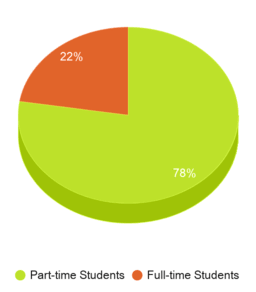

# Enrollment Undergraduate
198 students
328 students
# Full-Time Undergraduate Students
4,445 students
1,007 students
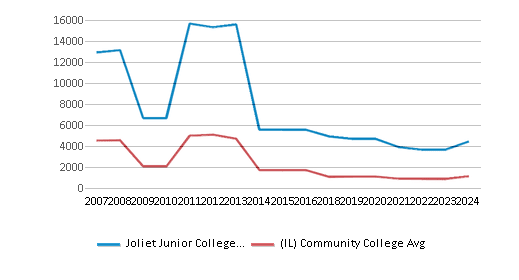
# Full-Time Graduate Students
n/a
43 students
# Part-Time Undergraduate Students
15,365 students
3,310 students
# Part-Time Graduate Students
n/a
18 students
Total Dormitory Capacity
n/a
132 students
% American Indian/Alaskan
1%
n/a
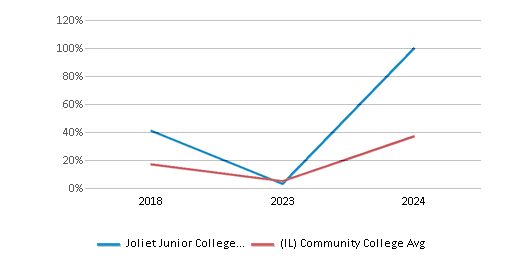
% Asian
3%
6%

% Hispanic
29%
26%

% Black
9%
13%
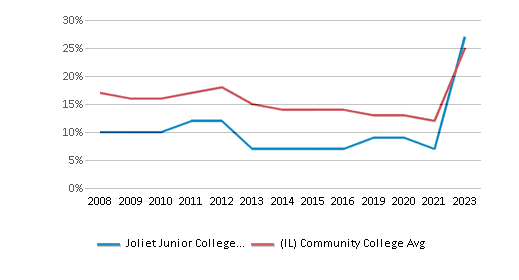
% White
52%
47%

% Hawaiian
n/a
n/a

% Two or more races
3%
3%

% Non Resident races
n/a
1%

% Unknown races
3%
4%

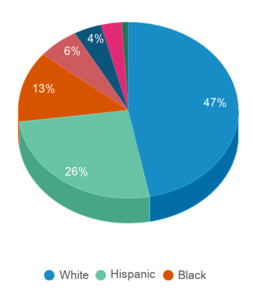
Diversity Score
0.64
0.69

College Completion Rate (Students who graduate in less than 4 years)
0.1797%
0.4%

College Completion Rate (Students who graduate in 4 years or more than 4 years)
n/a
0.38%
Average Graduate Earnings (10 Years)
$35,000
$31,800

Tuition and Acceptance Rate
The public in-state tuition of $9,369 is more than the state average of $7,875. The in-state tuition has grown by 111% over four years.
The public out-state tuition of $10,006 is less than the state average of $10,847. The out-state tuition has grown by 125% over four years.
In-State Tuition Fees
$9,369
$7,875

Out-State Tuition Fees
$10,006
$10,847

% Students Receiving Some Financial Aid
70%
82%
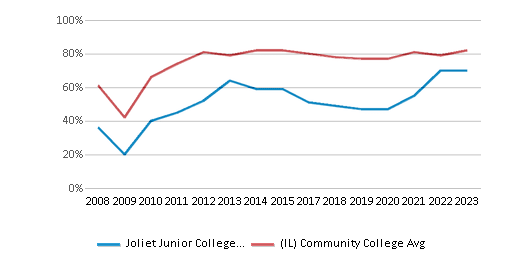
Median Debt for Graduates
$9,784
$8,187

Median Debt for Dropouts
$5,249
$4,618

Acceptance Rate
n/a
89%
SAT Reading
n/a
390
SAT Math
n/a
360
SAT Writing
n/a
355
ACT Composite
n/a
17
ACT English
n/a
17
ACT Math
n/a
17
Source: 2024 (or latest year available) Integrated Postsecondary Education Data System (IPEDS) , School Administrators
School Notes
- Joliet Junior College is a comprehensive community college. The college offers pre-baccalaureate programs for students planning to transfer to a four-year university, occupational education leading directly to employment, adult education and literacy programs, work force and workplace development services, and support services to help students succeed. JJC, America's oldest public community college, began in 1901 as an experimental postgraduate high school program. It was the "brain child" of J. Stanley Brown, Superintendent of Joliet Township High School, and William Rainey Harper, President of the University of Chicago. The college's initial enrollment was six students. Today, JJC serves more than 10,000 students in credit classes and 21,000 students in noncredit courses. Joliet Junior College's Main Campus is located at 1215 Houbolt Road, Joliet. The Main Campus facility boasts the Arthur G. and Vera C. Smith Business and Technology Center, a 90,000-square-foot building which houses several state-of-the-art microcomputer labs used by many of JJC's academic departments. In 2000, the college opened the Veterinary Technology and Industrial Training Building, which houses the faculty, classrooms and laboratories of the Veterinary Medical Technology degree program and facilities for the Institute of Economic Technology to conduct industrial training programs for business and industry. The Main Campus also has a full-service cafeteria, kitchen for Culinary Arts students, the Fine Arts Theatre, the Laura A. Sprague Art Gallery, the Herbert Trackman Planetarium, the Cyber Caf', the Fitness Center, gymnasium, business offices, including the President's Office, human resources, financial aid, registration and payment center, and many other amenities.
Frequently Asked Questions
How much does Joliet Junior College cost?
Joliet Junior College's tuition is approximately $9,369 for In-State students and $10,006 for Out-State students.
What is Joliet Junior College's ranking?
Joliet Junior College ranks among the top 20% of community college in Illinois for: Largest student body.
Recent Articles

Obtaining Your Bachelor's Degree at a Community College
Explore the evolving landscape of community colleges offering bachelor's degrees, addressing affordability, accessibility, and workforce needs.

A to Z of Community College Certificates and Courses
From business and healthcare to technology and skilled trades, the article showcases the breadth of options available to students seeking to enhance their knowledge, develop new skills, or pursue career advancement.

What is a Community College?
This comprehensive guide explains what a community college is, its history, and its role in higher education. It covers the types of programs offered, differences from four-year colleges, benefits of attending, and important considerations for prospective students, providing valuable insights for those exploring educational options.










